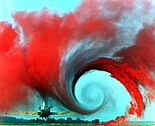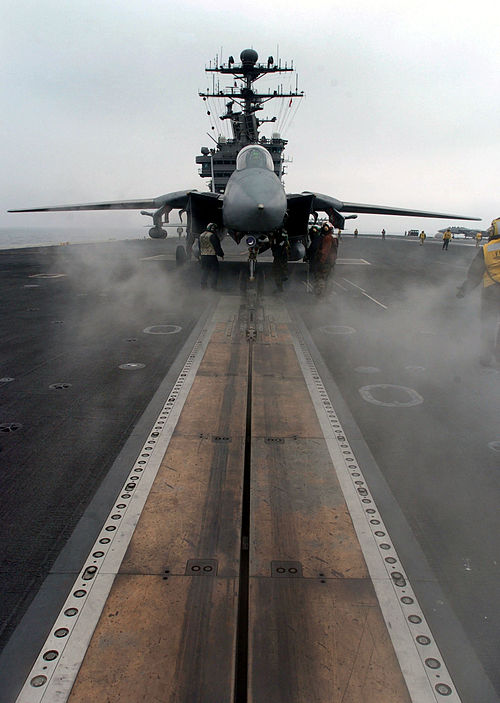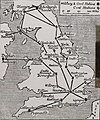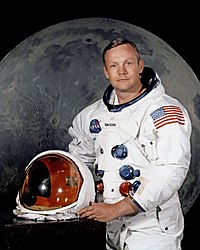| Main page | Categories & Main topics |
|
Tasks and Projects |
The Aviation Portal

Aviation includes the activities surrounding mechanical flight and the aircraft industry. Aircraft includes fixed-wing and rotary-wing types, morphable wings, wing-less lifting bodies, as well as lighter-than-air aircraft such as hot air balloons and airships.
Aviation began in the 18th century with the development of the hot air balloon, an apparatus capable of atmospheric displacement through buoyancy. Some of the most significant advancements in aviation technology came with the controlled gliding flying of Otto Lilienthal in 1896; then a large step in significance came with the construction of the first powered airplane by the Wright brothers in the early 1900s. Since that time, aviation has been technologically revolutionized by the introduction of the jet which permitted a major form of transport throughout the world. (Full article...)
Selected article
External aerodynamics is the study of flow around solid objects of various shapes. Evaluating the lift and drag on an airplane, the shock waves that form in front of the nose of a rocket is an example of external aerodynamics. Internal aerodynamics is the study of flow through passages in solid objects. For instance, internal aerodynamics encompasses the study of the airflow through a jet engine.
The ratio of the problem's characteristic flow speed to the speed of sound comprises a second classification of aerodynamic problems. A problem is called subsonic if all the speeds in the problem are less than the speed of sound, transonic if speeds both below and above the speed of sound are present (normally when the characteristic speed is approximately the speed of sound), supersonic when the characteristic flow speed is greater than the speed of sound, and hypersonic when the flow speed is much greater than the speed of sound. Aerodynamicists disagree over the precise definition of hypersonic flow; minimum Mach numbers for hypersonic flow range from 3 to 12. Most aerodynamicists use numbers between 5 and 8. (Full article...)
Selected image
Did you know
...that among the earliest accounts of the use of a man-lifting kite is in the story of Ishikawa Goemon's robbery from Nagoya Castle? ..that Elm Farm Ollie in 1930 became the first cow to be milked while flying in an airplane? ...that the asymmetrical monoplane BV 141 is one of many military aircraft designed by Richard Vogt?
General images -
In the news
- May 29: Austrian Airlines cancels Moscow-bound flight after Russia refuses a reroute outside Belarusian airspace
- August 8: Passenger flight crashes upon landing at Calicut airport in India
- June 4: Power firm helicopter strikes cables, crashes near Fairfield, California
- January 29: Former basketball player Kobe Bryant dies in helicopter crash, aged 41
- January 13: Iran admits downing Ukrainian jet, cites 'human error'
- January 10: Fire erupts in parking structure at Sola Airport, Norway
- October 27: US announces restrictions on flying to Cuba
- October 3: World War II era plane crashes in Connecticut, US, killing at least seven
- September 10: Nevada prop plane crash near Las Vegas leaves two dead, three injured
- August 6: French inventor Franky Zapata successfully crosses English Channel on jet-powered hoverboard
Related portals
Associated Wikimedia
The following Wikimedia Foundation sister projects provide more on this subject:
-
Commons
Free media repository -
Wikibooks
Free textbooks and manuals -
Wikidata
Free knowledge base -
Wikinews
Free-content news -
Wikiquote
Collection of quotations -
Wikisource
Free-content library -
Wikiversity
Free learning tools -
Wikivoyage
Free travel guide -
Wiktionary
Dictionary and thesaurus
Selected biography
Before becoming an astronaut, Armstrong was in the United States Navy and saw action in the Korean War. After the war, he served as a test pilot at the National Advisory Committee for Aeronautics (NACA) High-Speed Flight Station, now known as the Dryden Flight Research Center, where he flew over 900 flights in a variety of aircraft. As a research pilot, Armstrong served as project pilot on the F-100 Super Sabre A and C aircraft, F-101 Voodoo, and the Lockheed F-104A Starfighter. He also flew the Bell X-1B, Bell X-5, North American X-15, F-105 Thunderchief, F-106 Delta Dart, B-47 Stratojet, KC-135 Stratotanker and Paresev. He graduated from Purdue University.
Selected Aircraft

The Antonov An-225 Mriya (Антонов Ан-225 Мрія, NATO reporting name: Cossack) was a strategic airlift transport aircraft built by Antonov, and was the world's largest powered aircraft before its destruction in February 2022. Mriya (Мрія) means "dream" (inspiration) in Ukrainian.
With a maximum gross weight of 640,000 kg (1,400,000 lb), the An-225 was the world's heaviest aircraft. Although its wingspan is less than that of the Hughes H-4 "Spruce Goose", the latter never went beyond a single short low-altitude test flight, making the An-225 the largest aircraft in the world to take off more than once. Both the An-124 and An-225 are larger than the C-5 Galaxy, the largest aircraft in the U.S. inventory. The An-225 was also larger than the Airbus A380.
- Span: 88.40 m (291 ft 2 in)
- Length: 75.30 m n(246 ft 11 in)
- Height: 18.1 m (59.3 ft)
- Engines: 6× ZMKB Progress D-18 turbofans, 229 kN (51,600 lbf) each
- Cruising Speed: 750 km/h (400 knots, 465 mph)
- First Flight: December 21, 1988
Today in Aviation
- 2012 – a Yemeni Air Force Antonov An-26, a twin-engine turboprop military transport aircraft, crashed in Sana’a, Yemen’s capital, resulting in the deaths of all ten individuals on board, including five military officers.
- 2012 – A ceasefire brings fighting in the Gaza Strip between Israel and Hamas to an end.
- 2012 – JetBlue Flight 1329: An Embraer E190, taxis to its gate after landing at Baltimore-Washington International Airport in Anne Arundel County, Maryland, a fire breaks out in one of its engines. After the airliner reaches its gate, everyone on board evacuates the plane uninjured via the jetway while firefighters douse the fire.
- 2004 – China Eastern Airlines Flight 5210, a Bombardier CRJ200, stalls and crashes near Baotou, China shortly after takeoff because of frost contamination; all 53 on board and two people on the ground are killed.
- 2003 – OH-58D Kiowa 92-0605 from D Troop, 1–17 Cavalry Regiment written off, reason unknown.
- 1990 – First flight of the Hongdu JL-8
- 1989 – A British Airways Boeing 747 narrowly misses crashing into the Penta hotel near Heathrow Airport
- 1986 – The first ever RAF air-to-air refuelling of a fully-loaded passenger carrying transport aircraft. It was carried out on a trooper flight to Oman as part of Exercise Saif Sareea. The refuelling took place over Sicily as part of the 4,200 mile, 9 h flight.
- 1981 – Aeroflot is banned from flying to the United States, after an earlier Aeroflot flight that overflew American military installations, straying from its supposed flight path.
- 1980 – Continental Micronesia Flight 614, a Boeing 727, crashes on landing at Yap International Airport; all on board survive.
- 1970 – US aircraft begin the first major bombing campaign of North Vietnam since 1968. 300 aircraft attack the Mu Gia and Ban Gari passes.
- 1959 – Ariana Afghan Airlines Flight 202, a Douglas DC-4, crashes after an apparent in-flight fire, killing 24 of 27 on board.
- 1958 – Fairey Gannet AS.1, WN345, fitted with Armstrong Siddeley ASMD.8 Double Mamba 112 coupled turboprop powerplant, suffers belly landing this date during test programme, caused by a partially retracted nosewheel. The pilot tries unsuccessfully to get the gear to deploy. Lands gear-up on foam-covered runway 22 at Bitteswell, suffering minimal damage. Repaired, it is back in the air within weeks.
- 1952 – First flight of the Percival Pembroke
- 1948 – The Roundel, the RCAF service publication, made its first appearance.
- 1947 – First flight of the Grumman F9F Panther
- 1917 – 21-24 – The Zeppelin LZ-104 "Das Afrika-Schiff" makes a 6,757 km journey through Africa in 96 hours (average speed 71 km/h).
- 1914 – Three RNAS Avro 504s bomb the Zeppelin sheds at Friedrichshafen.
- 1783 – In a flight lasting 25 min, de Rozier and d'Arlandes take the first untethered ride in a Montgolfière in Paris, the first human passengers carried in free flight by a hot-air balloon.
References
- Shortcuts to this page: Portal:Airplanes • P:AVIA





















































